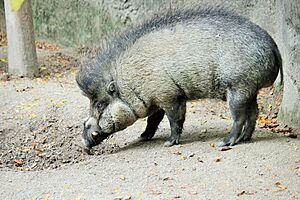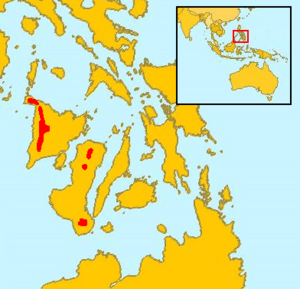Visayan warty pig facts for kids
The Visayan warty pig (Sus cebifrons) is a type of wild pig that is in great danger of disappearing forever. It lives only on a few islands in the central Philippines. These islands include Cebu, Negros, Panay, Masbate, Guimaras, and Siquijor. People in the Philippines call this pig by different names, like baboy ilahas (which means 'wild pig') or baboy talonon ('forest pig').
The Visayan warty pig is critically endangered because its home is being destroyed and because people hunt it. It is thought to have disappeared from four of the islands where it used to live. Only small groups are left on Negros and Panay. Because so few Visayan warty pigs remain in the wild, scientists do not know much about how they behave. However, in 2012, cameras set up in the Northern Negros Natural Park took the first wild photos of these pigs.
Quick facts for kids Visayan warty pig |
|
|---|---|
 |
|
| A Visayan warty pig at Cincinnati Zoo, Ohio | |
| Conservation status | |
| Scientific classification | |
| Genus: |
Sus
|
| Species: |
cebifrons
|
 |
|
| Geographic range of Sus cebifrons | |
| Synonyms | |
|
Verrucophorus cebifrons |
|
Contents
Where Visayan Warty Pigs Live
The Visayan warty pig is found only on six islands in the Philippines. These are Cebu, Negros, Panay, Masbate, Guimaras, and Siquijor. Sadly, scientists have only found groups of these pigs still living on Negros and Panay.
It is believed that the pigs have disappeared from all the other islands. There is a small chance that some might still be living on Masbate.
Different Types of Visayan Warty Pigs
This species has two main types, called subspecies:
- The Cebu warty pig (Sus cebifrons cebifrons) is believed to be extinct. This means it has completely disappeared.
- The Negros warty pig (Sus cebifrons negrinus) still exists. There are two separate groups of these pigs. One group lives on Negros, and the other lives on Panay. These two groups have been separated for about 12,000 years, since the last ice age.
What Visayan Warty Pigs Look Like
The Visayan warty pig gets its name from the three pairs of fleshy "warts" on the face of the male pigs (boars). Scientists think these warts help protect the boars' faces. They might act like a natural shield during fights with other pigs. Male pigs also have stiff, spiky hair that grows on their backs.
Behavior and Diet
Visayan warty pigs usually live in small groups of four to six pigs. They mostly eat roots, tubers (like potatoes), and fruits they find in the forest. They might also eat crops grown by farmers.
About 95% of their natural home has been cleared by farmers. These farmers cut down forests to plant their crops. This means the pigs have less natural food. So, they eat more of the farmers' crops. After a few years, the land cleared for farming often becomes poor and cannot grow much. This makes it even harder for the pigs to find food. This lack of food is a big reason why their numbers are shrinking.
Interestingly, Visayan warty pigs were the first pig species ever seen using tools. They used them for digging at a zoo in France.
Reproduction and Life Cycle
Baby Visayan warty pigs, called piglets, are often seen during the dry season. This is usually between January and March in their natural home. A mother pig typically has three to four piglets in each litter.
Protecting Visayan Warty Pigs
The biggest danger to the Visayan warty pig is the loss of its home. This happens because of commercial logging (cutting down trees for wood) and slash-and-burn farming. In total, 98% of their original forest home is gone. People also hunt these pigs for food. Farmers sometimes hunt them too, because the pigs can damage their crops.
Visayan warty pigs can also mix with wild domestic pigs. This can change their genes and make it harder for the pure species to survive.
Breeding Programs
There are special programs to help save the Negros warty pig (S. c. negrinus). Zoos like the Rotterdam Zoo have successful breeding programs for pigs from Negros. The San Diego Zoo has a program for pigs from Panay. These programs help increase the number of pigs in a safe environment.
Pigs in Zoos
Many zoos around the world are helping to protect Visayan warty pigs. In the Philippines, the Crocolandia Foundation and the Negros Forests and Ecological Foundation care for these pigs.
In Europe, more than 30 zoos keep the Negros Island type of this pig. These include Jersey Zoo, Rotterdam Zoo, Chester Zoo, and Edinburgh Zoo. Several zoos in the United States also have them. The San Diego Zoo was the first zoo outside the Philippines to keep and breed these pigs. Other zoos in North America, like those in Seattle, Los Angeles, Cincinnati, and Apple Valley, also have them.
See also
- Wild pigs of the Philippines





